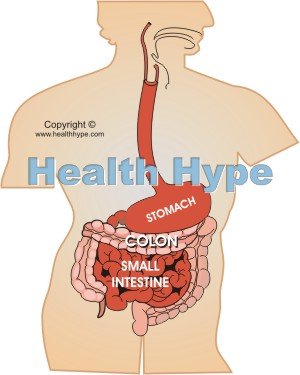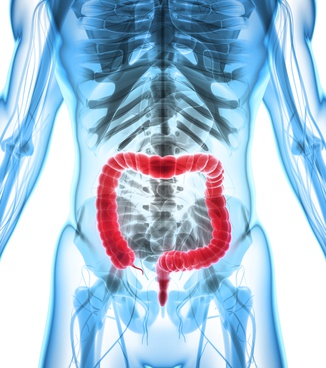Blocked Bowels (Colon) – Small or Large Intestine Obstruction
The small and large intestine comprise the longest part of the digestive tract. It starts with the small intestine that starts from the end part of the stomach and ends at the anal canal. The small intestine is approximately 20 feet (6 meters) long and is coiled to fit within the abdominal cavity. The large intestine is far shorter but wider. Obstruction within the small or large intestine occurs for several possible reasons.
Blocked Bowels
Obstruction within the small intestine (small bowel obstruction or SBO) is more common than a blockage elsewhere in the gastrointestinal tract. Given its length and structure, it is more prone to a number of causes that can result in a partial or complete obstruction. Any strangulation which compromises blood flow to the bowel is considered as a medical emergency and needs immediate treatment, usually surgical intervention.

Signs and Symptoms
The most common signs and symptoms include :
- Abdominal distention
- Abdominal pain
- Constipation
- Vomiting with or without nausea
Intestinal obstruction should always be ruled out upon the presentation of these signs and symptoms. Other signs and symptoms which may vary among indidvidual cases or present early or late in the case includes :
- Diarrhea
- Fever
- Increased heart rate (tachycardia)
- Signs of bleeding in the stool (melena ~ dark blood, hematochezia ~ fresh blood)
Causes of a Blocked Bowel
Most cases of small bowel obstruction are due to mechanical causes. A small portion of cases are due to impaired intestinal motility, thereby preventing the flow of chyme further down the gastrointestinal tract. This causes intestinal contents to become ‘backed up’.
The most common causes of mechanical small bowel obstruction are :
- Adhesions
- Hernias
- Intussusception
- Tumors
- Volvulus
Adhesions
Adhesions often arise postoperatively and are closely linked to the increasing number of laparotomies conducted globally. Other causes include infection, peritonitis and endometriosis. These adhesions may form fibrous bridges which trap surrounding organs and strangulate the bowel.
Usually there is a history of surgery, with symptoms typically arising within 4 weeks after the surgery. Less frequently it may occur decades afterwards. Rare causes include congenital adhesions but this should only be considered when other causes have been excluded.
Hernias
Outpouchings of the peritoneal wall may create dilated sacs with a narrow orifice (entry point). Any abdominal structure can get trapped, usually partially, within the external herniations but the loops of the small intestine are the most prone. These loops may become strangulated at the orifice thereby resulting in ischemia as explained below.
Intussusception
A portion of the small intestine protrudes into an adjacent portion in a telescopic manner. There is often a structural defect that allows for a weakened part to protrude in this manner, pushed through by peristaltic waves. Over time, an intestinal obstruction may arise and can even lead to an infarction as described below.
Tumors
Both benign and malignant tumors of the small intestine may cause intestinal obstruction. Polyps may also cause small bowel obstruction although it is more likely to occur in the large intestine.
- Benign
- Leiomyomas
- Lipomas
- Fibromas
- Neurofibromas
- Malignant
- Adenocarcinoma
- Lymphomas
- Carcinoid tumors
- Kaposi’s sarcoma (always consider HIV/AIDS)
Volvulus
A volvulus occurs when a portion of the bowel, either large or small, rotates and the twisting causes an obstruction and leads to strangulation with ischemia. The large bowel is more likely to be affected and it may trap the small intestine within the twist. However, the twisting may occur with the small intestine itself.
Chronic Intestinal Pseudo-Obstruction
This occurs when intestinal motility is affected at a portion of the small intestine. Chyme is not propelled efficiently beyond this point and ‘backs up’ thereby causing a mechanical obstruction. The problem with intestinal motility may be due to the smooth muscle of the small bowel or the nerves supplying it. Primary idiopathic intestinal pseudo-obstruction may be a result of unknown causes (idiopathic), familial or congenital disorders of the smooth muscle and/or neurological disorders. It can also arise secondary to many conditions like Parkinsonism, hypothyroidism, scleroderma or due to drugs like opiates and tricyclic antidepressants.
Inflammatory Bowel Disease
Intestinal obstruction may arise in Crohn’s disease. Prolonged inflammation in Crohn’s disease may result in hypertrophy and fibrosis of the wall of the bowel and this can then result in strictures.
Other Causes of a Blocked Bowel
- Gallstones (gallstone ileus)
- Foreign body
Ischemia
Ischemic bowel disease may result in an infarction if left untreated. The infarct may affect the mucosa only (mucosal infarction), mucosa and submucosa (mural infarction) or all three layers of the bowel wall (transmural infarction). Intestinal tissue dies due to a lack of oxygen often as a result of the above causes, and this will affect motility, result in edema and could eventually form strictures over time. All of these mechanisms could result in bowel obstruction. The blockage may arise in ischemic bowel disease even if the ischemia is not due to one of the causes mentioned above, as in cytomegalovirus (CMV) infection or radiation enterocolitis.
Blocked Colon
An obstruction within the large intestine could stem from within the cecum, colon (ascending, transverse, descending, sigmoid) or rectum. The blockage may be partial or complete, and like small intestinal obstruction, it should be treated as a medical emergency. Most of the causes of a large intestine obstruction are mechanical in nature.

Signs and Symptoms
The main clinical features include :
- Constipation, known as obstipation when severe constipation is due to bowel obstruction.
- Abdominal distention and bloating
- Abdominal pain (cramps)
- Failure to pass stool or gas indicates complete obstruction or diminished passage of stool and gas indicates partial obstruction. A change in the size and form of the stool may also be noticed.
Additional signs and symptoms include :
- Nausea and vomiting may arise as the condition progresses resulting in backed up contents as far as the small intestine.
- Diarrhea in a partial obstruction
- Melena or hematochezia may be noticed when passing some stool in a partial obstruction
- Increased bowel sounds (borborygmi) which may be followed by diminished sounds as the condition progresses
Causes of Colon Obstruction
Many of the causes of small intestine obstruction may also affect the large intestine. This includes :
Hernia
Portion of the colon is trapped within an outpouching (incarcerated hernia).
Intussusception
This is the collapsing of one part of the colon into a the adjacent distal portion in a telescopic manner. Intussusception is more likely to be seen in newborns and young infants.
Volvulus
Twisting of the large intestine resulting in strictures. It may also trap a portion of the small intestine in the twist. It is more likely to affect the cecum or sigmoid colon.
Tumors and polyps
In most cases, a mass is asymptomatic unless it grows to a degree that significantly occludes the lumen. In malignancies (colon or colorectal cancer), diarrhea and constipation may be more noticeable along with hematochezia (fresh blood in the stool).
Inflammatory bowel disease
Chronic inflammation of the colon results in hypertrophy and subsequent fibrosis of the colonic wall. This may be seen in both Crohn’s disease or ulcerative colitis and the latter may be associated with polyposis syndromes.
Diverticulitis
This is the inflammation of small pouches that arise in the colon known as diverticula. Persistent inflammation or even an infection can lead to the formation of scar tissue which may result in a partial obstruction.
Impacted feces
The collection of a large, hard mass of stool in the rectum. This tends to occur in the frail or elderly, after the use of drugs that cause severe constipation, neurological disorders that affect involuntary defecation, and any condition that contributes towards painful defecation thereby causing the person to avoid defecating.
Acute colonic pseudo-obstruction
Also known as Ogilvie’s syndrome, it is the sudden painless distention of the proximal parts of the colon. Acute colonic pseudo-obstruction tends to arise in the following situations :
- Recent surgery
- Trauma
- Burns
- Diabetes mellitus
- Certain drugs
- Uremia
- Severe dehydration
Hirschsprung’s disease
This is a congenital defect where the ganglion cells of a segment of the colon is missing or dysfunctional. It can result in an enlargement (dilatation) of the colon (megacolon) with no reflex contraction and colonic motility is disrupted. Fecal matter can collect in this area thereby resulting in an obstruction.
Ischemic Bowel Disease
While this is a complication of strangulating obstructions like a volvulus, any other cause of bowel ischemia or infarction may also contribute to an obstruction as a result of edema, disturbed motility or strictures.
Other causes :
- Gallstone ileus
- Foreign bodies
- Large tumor outside of the colon
References
- Large Bowel Obstruction. Emedicine
- Small Bowel Obstruction. Emedicine
- Intestinal Obstruction. Merck
Last updated on August 27, 2018.





